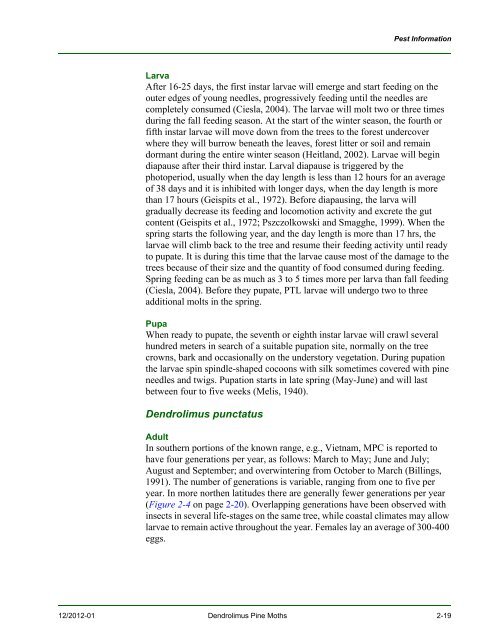New Pest Response Guidelines - aphis - US Department of Agriculture
New Pest Response Guidelines - aphis - US Department of Agriculture
New Pest Response Guidelines - aphis - US Department of Agriculture
Create successful ePaper yourself
Turn your PDF publications into a flip-book with our unique Google optimized e-Paper software.
<strong>Pest</strong> Information<br />
Larva<br />
After 16-25 days, the first instar larvae will emerge and start feeding on the<br />
outer edges <strong>of</strong> young needles, progressively feeding until the needles are<br />
completely consumed (Ciesla, 2004). The larvae will molt two or three times<br />
during the fall feeding season. At the start <strong>of</strong> the winter season, the fourth or<br />
fifth instar larvae will move down from the trees to the forest undercover<br />
where they will burrow beneath the leaves, forest litter or soil and remain<br />
dormant during the entire winter season (Heitland, 2002). Larvae will begin<br />
diapause after their third instar. Larval diapause is triggered by the<br />
photoperiod, usually when the day length is less than 12 hours for an average<br />
<strong>of</strong> 38 days and it is inhibited with longer days, when the day length is more<br />
than 17 hours (Geispits et al., 1972). Before diapausing, the larva will<br />
gradually decrease its feeding and locomotion activity and excrete the gut<br />
content (Geispits et al., 1972; Pszczolkowski and Smagghe, 1999). When the<br />
spring starts the following year, and the day length is more than 17 hrs, the<br />
larvae will climb back to the tree and resume their feeding activity until ready<br />
to pupate. It is during this time that the larvae cause most <strong>of</strong> the damage to the<br />
trees because <strong>of</strong> their size and the quantity <strong>of</strong> food consumed during feeding.<br />
Spring feeding can be as much as 3 to 5 times more per larva than fall feeding<br />
(Ciesla, 2004). Before they pupate, PTL larvae will undergo two to three<br />
additional molts in the spring.<br />
Pupa<br />
When ready to pupate, the seventh or eighth instar larvae will crawl several<br />
hundred meters in search <strong>of</strong> a suitable pupation site, normally on the tree<br />
crowns, bark and occasionally on the understory vegetation. During pupation<br />
the larvae spin spindle-shaped cocoons with silk sometimes covered with pine<br />
needles and twigs. Pupation starts in late spring (May-June) and will last<br />
between four to five weeks (Melis, 1940).<br />
Dendrolimus punctatus<br />
Adult<br />
In southern portions <strong>of</strong> the known range, e.g., Vietnam, MPC is reported to<br />
have four generations per year, as follows: March to May; June and July;<br />
August and September; and overwintering from October to March (Billings,<br />
1991). The number <strong>of</strong> generations is variable, ranging from one to five per<br />
year. In more northen latitudes there are generally fewer generations per year<br />
(Figure 2-4 on page 2-20). Overlapping generations have been observed with<br />
insects in several life-stages on the same tree, while coastal climates may allow<br />
larvae to remain active throughout the year. Females lay an average <strong>of</strong> 300-400<br />
eggs.<br />
12/2012-01 Dendrolimus Pine Moths 2-19

















